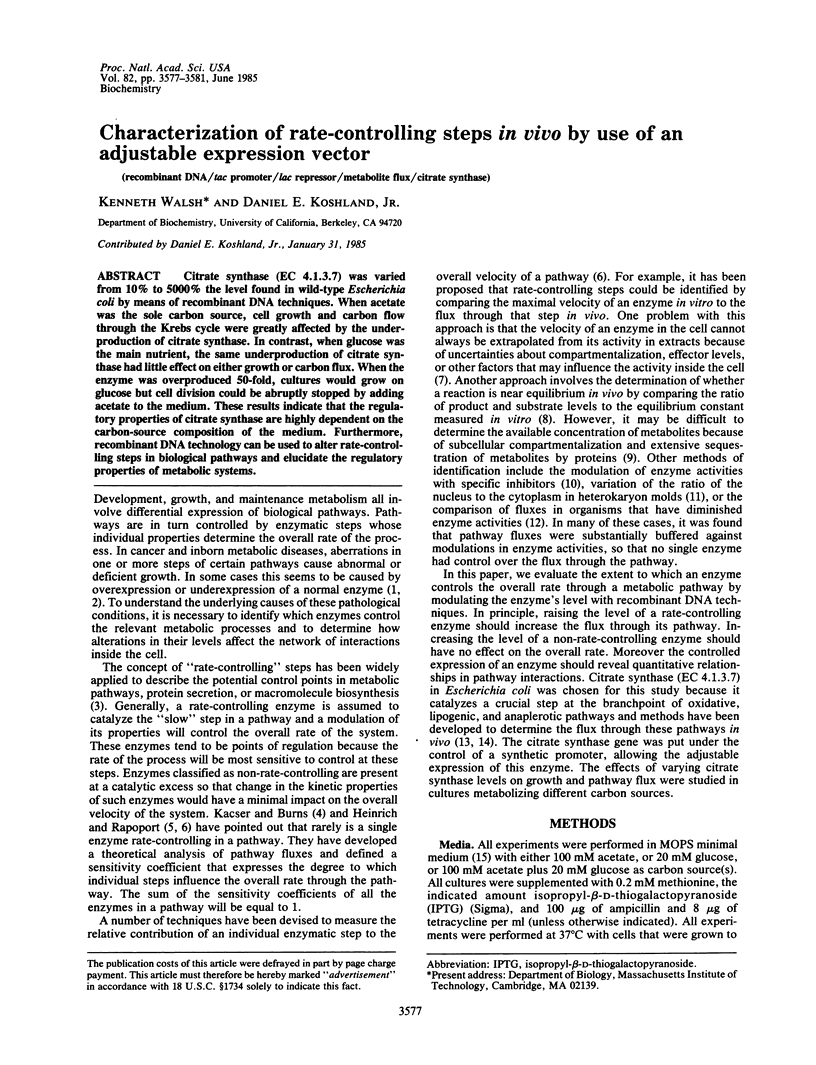Abstract
Citrate synthase (EC 4.1.3.7) was varied from 10% to 5000% the level found in wild-type Escherichia coli by means of recombinant DNA techniques. When acetate was the sole carbon source, cell growth and carbon flow through the Krebs cycle were greatly affected by the under-production of citrate synthase. In contrast, when glucose was the main nutrient, the same underproduction of citrate synthase had little effect on either growth or carbon flux. When the enzyme was overproduced 50-fold, cultures would grow on glucose but cell division could be abruptly stopped by adding acetate to the medium. These results indicate that the regulatory properties of citrate synthase are highly dependent on the carbon-source composition of the medium. Furthermore, recombinant DNA technology can be used to alter rate-controlling steps in biological pathways and elucidate the regulatory properties of metabolic systems.
Full text
PDF




Selected References
These references are in PubMed. This may not be the complete list of references from this article.
- Calos M. P. DNA sequence for a low-level promoter of the lac repressor gene and an 'up' promoter mutation. Nature. 1978 Aug 24;274(5673):762–765. doi: 10.1038/274762a0. [DOI] [PubMed] [Google Scholar]
- Cepko C. L., Roberts B. E., Mulligan R. C. Construction and applications of a highly transmissible murine retrovirus shuttle vector. Cell. 1984 Jul;37(3):1053–1062. doi: 10.1016/0092-8674(84)90440-9. [DOI] [PubMed] [Google Scholar]
- Danson M. J., Harford S., Weitzman P. D. Studies on a mutant form of Escherichia coli citrate synthase desensitised to allosteric effectors. Eur J Biochem. 1979 Nov;101(2):515–521. doi: 10.1111/j.1432-1033.1979.tb19746.x. [DOI] [PubMed] [Google Scholar]
- Flint H. J., Tateson R. W., Barthelmess I. B., Porteous D. J., Donachie W. D., Kacser H. Control of the flux in the arginine pathway of Neurospora crassa. Modulations of enzyme activity and concentration. Biochem J. 1981 Nov 15;200(2):231–246. doi: 10.1042/bj2000231. [DOI] [PMC free article] [PubMed] [Google Scholar]
- Greksák M., Lopes-Cardozo M., van den Bergh S. G. Citrate synthesis in intact rat-liver mitochondria is irreversible. Eur J Biochem. 1982 Feb;122(2):423–427. doi: 10.1111/j.1432-1033.1982.tb05897.x. [DOI] [PubMed] [Google Scholar]
- Groen A. K., Wanders R. J., Westerhoff H. V., van der Meer R., Tager J. M. Quantification of the contribution of various steps to the control of mitochondrial respiration. J Biol Chem. 1982 Mar 25;257(6):2754–2757. [PubMed] [Google Scholar]
- Guest J. R. Hybrid plasmids containing the citrate synthase gene (gltA) of Escherichia coli K12. J Gen Microbiol. 1981 May;124(1):17–23. doi: 10.1099/00221287-124-1-17. [DOI] [PubMed] [Google Scholar]
- Gumaa K. A., McLean P., Greenbaum A. L. Calculation of the intracellular distribution of acetyl CoA and CoA, based on the use of citrate synthase as an equilibrium enzyme. FEBS Lett. 1973 Jan 15;29(2):193–196. doi: 10.1016/0014-5793(73)80559-9. [DOI] [PubMed] [Google Scholar]
- Heinrich R., Rapoport S. M., Rapoport T. A. Metabolic regulation and mathematical models. Prog Biophys Mol Biol. 1977;32(1):1–82. [PubMed] [Google Scholar]
- Heinrich R., Rapoport T. A. A linear steady-state treatment of enzymatic chains. General properties, control and effector strength. Eur J Biochem. 1974 Feb 15;42(1):89–95. doi: 10.1111/j.1432-1033.1974.tb03318.x. [DOI] [PubMed] [Google Scholar]
- LaPorte D. C., Walsh K., Koshland D. E., Jr The branch point effect. Ultrasensitivity and subsensitivity to metabolic control. J Biol Chem. 1984 Nov 25;259(22):14068–14075. [PubMed] [Google Scholar]
- Leder P., Battey J., Lenoir G., Moulding C., Murphy W., Potter H., Stewart T., Taub R. Translocations among antibody genes in human cancer. Science. 1983 Nov 18;222(4625):765–771. doi: 10.1126/science.6356357. [DOI] [PubMed] [Google Scholar]
- Mayo K. E., Warren R., Palmiter R. D. The mouse metallothionein-I gene is transcriptionally regulated by cadmium following transfection into human or mouse cells. Cell. 1982 May;29(1):99–108. doi: 10.1016/0092-8674(82)90094-0. [DOI] [PubMed] [Google Scholar]
- Middleton R. J., Kacser H. Enzyme variation, metabolic flux and fitness: alcohol dehydrogenase in Drosophila melanogaster. Genetics. 1983 Nov;105(3):633–650. doi: 10.1093/genetics/105.3.633. [DOI] [PMC free article] [PubMed] [Google Scholar]
- Neidhardt F. C., Bloch P. L., Smith D. F. Culture medium for enterobacteria. J Bacteriol. 1974 Sep;119(3):736–747. doi: 10.1128/jb.119.3.736-747.1974. [DOI] [PMC free article] [PubMed] [Google Scholar]
- Palmiter R. D., Chen H. Y., Brinster R. L. Differential regulation of metallothionein-thymidine kinase fusion genes in transgenic mice and their offspring. Cell. 1982 Jun;29(2):701–710. doi: 10.1016/0092-8674(82)90186-6. [DOI] [PubMed] [Google Scholar]
- Srere P. A. The enzymology of the formation and breakdown of citrate. Adv Enzymol Relat Areas Mol Biol. 1975;43:57–101. doi: 10.1002/9780470122884.ch2. [DOI] [PubMed] [Google Scholar]
- Stewart T. A., Pattengale P. K., Leder P. Spontaneous mammary adenocarcinomas in transgenic mice that carry and express MTV/myc fusion genes. Cell. 1984 Oct;38(3):627–637. doi: 10.1016/0092-8674(84)90257-5. [DOI] [PubMed] [Google Scholar]
- Struhl K. The new yeast genetics. 1983 Sep 29-Oct 5Nature. 305(5933):391–397. doi: 10.1038/305391a0. [DOI] [PubMed] [Google Scholar]
- Walsh K., Koshland D. E., Jr Determination of flux through the branch point of two metabolic cycles. The tricarboxylic acid cycle and the glyoxylate shunt. J Biol Chem. 1984 Aug 10;259(15):9646–9654. [PubMed] [Google Scholar]
- Weitzman P. D., Danson M. J. Citrate synthase. Curr Top Cell Regul. 1976;10:161–204. doi: 10.1016/b978-0-12-152810-2.50011-5. [DOI] [PubMed] [Google Scholar]
- de Boer H. A., Comstock L. J., Vasser M. The tac promoter: a functional hybrid derived from the trp and lac promoters. Proc Natl Acad Sci U S A. 1983 Jan;80(1):21–25. doi: 10.1073/pnas.80.1.21. [DOI] [PMC free article] [PubMed] [Google Scholar]


